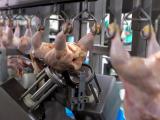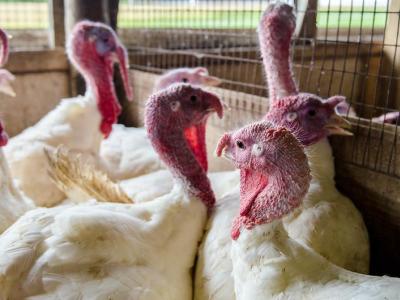A multistate Salmonella outbreak has so far sickened 278 people in 18 states, which prompted a public health alert yesterday from the US Department of Agriculture (USDA) and has led the US Centers for Disease Control and Prevention (CDC) to recall some staff sidelined by the federal government shutdown.
Despite the partial shutdown, some food safety functions are continuing at federal agencies, but it's not business as usual. The USDA's Food Safety and Inspection Service (FSIS) warned the public that illnesses from Salmonella Heidelberg strains have been associated with raw chicken products produced at three Foster Farms facilities in California.
So far most of the cases have been reported in California, and the FSIS said the products were mainly distributed to retail stores in California, Oregon, and Washington state. The agency said investigations by local, state, and federal officials have found that the likely source of the outbreak is eating Foster Farms chicken or other brands produced at the same facilities.
The FSIS said the CDC has partnered with state health departments to monitor the outbreak and that the FSIS is prepared to expand the investigation if new evidence emerges.
Foster Farms said in a statement yesterday that it was working with the USDA and CDC to reduce the incidence of Salmonella Heidelberg in raw chicken produced at its three facilities in central California. As the agencies continue to investigate the issue, Foster Farms has taken additional control steps that have already been shown to be effective at reducing levels at its plants in the Pacific Northwest, officials said.
The company said it hasn't issued a recall. It reiterated FSIS advice on steps consumers can take to safely handle raw poultry, such as cooking the meat to an internal temperature of 165 degrees. Foster Farms officials said they regretted any illnesses that may be associated with their products and that they have retained a panel of national experts to review their current practices and identify additional steps for improvement.
Some workers kept on the job
Food safety advocates and other observers have worried about the potential effects of the federal government shutdown in an outbreak scenario. Contingency plans have kept FSIS workers on the job who are involved with food inspections and safety, though the federal situation has thinned the ranks of officials who monitor outbreaks at the CDC.
Christopher Braden, MD, who directs the CDC's division of foodborne, waterborne, and environmental diseases, told CIDRAP News that furloughs initially sidelined many database workers and epidemiologists involved in PulseNet, a national molecular subtyping network that supports foodborne illness investigations. However, federal officials have been tracking the Salmonella Heidelberg infections since June, and the CDC exempted or excepted employees who have been monitoring the outbreak closely.
He said that going into the shutdown, the CDC had only enough staffing to cover known risks and protect the public from them, and that since the start of the shutdown the bare-bones staff have also been keeping their eye on about 30 other illness clusters. Given the latest outbreak developments, the CDC has brought the PulseNet staff back almost to full strength, Braden said.
"What we are missing are the potential risks," he added.
For antibiotic resistance testing, the CDC has only enough staff to take urgent or unusual requests, and for now cannot handle routine testing on samples submitted by states. Braden said tests on the Salmonella Heidelberg strains involved in the outbreak show that some are resistant to multiple antibiotics.
The CDC typically releases an initial outbreak investigation announcement when its federal partners issue their alerts and recall notices, but the information and map of affected states is missing from the CDC's Web site. Braden said the federal funding lapse has slowed reporting, but he expects the agency to post its initial findings tomorrow.
State probes not hampered
So far the federal cutbacks haven't kept states from investigating their Salmonella Heidelberg outbreak infections, according to a sampling of health officials contacted by CIDRAP News.
Donn Moyer, a spokesman for the Washington State Department of Health, said so far 15 Salmonella Heidelberg infections in Washington have been linked to the outbreak. He said the department does its own disease investigations and consults with federal officials as needed, and so far the shutdown hasn't had any specific impact on state investigations.
Moyer also said the outbreak time frame, from Mar 1 through Sep 25, predates the government shutdown. He said if the shutdown goes on a for a long time, state officials could face slowdowns or disruptions.
Katrina Hedberg, MD, MPH, state epidemiologist with the Oregon Public Health Division, said seven infections in Orgeon have been linked to the outbreak. She said a variety of pulsed-field gel electrophoresis (PFGE) patterns are among the outbreak strains and that five of them have been found in the Oregon cases. Health officials have signaled that more than 200 of the cases are from California, she noted.
She said Oregon's state lab does its own PFGE testing and outbreak tracking, and so far the federal shutdown hasn't caused any problems with the latest investigation. She noted that commissioned corps members at CDC and in state offices are still on the job, but with fewer staff.
Hedberg said she found it unusual that the public health alert came from the USDA rather than the CDC.
Last year, she said, Oregon had another Salmonella outbreak linked to a Foster Farms facility in the Pacific Northwest, but it involved a different strain. The new outbreak raises questions about the levels of bacteria coming out of the plants, she added. Salmonella isn't considered an adulterant in chicken, and consumers are often reminded about steps to avoid cross-contamination and to use proper hand washing techinque.
It's not likely that consumer food safety practices have changed much, which should focus attention on any potential changes in practices at the poultry processing plants that might be fueling the outbreak, Hedberg said.
In the earlier outbreak linked to Foster Farms chicken, the CDC reported 134 illnesses in 13 states, most of them in Oregon and Washington. Tests by the Washington State Department of Health found the outbreak strain in four intact samples from sick patients' homes, which were traced to two Foster Farms slaughter establishments.
In its final update on the outbreak on Jul 10 the CDC said the FSIS sent an incident investigation team to one of the plants and that the results of the investigation were being finalized.
See also:
Oct 7 FSIS news release
Oct 1 FSIS notice on contingency plans
FSIS funding gap plan
Oct 7 Foster Farms press release
Jul 11 CIDRAP News item "Salmonella strain in 2012-13 chicken outbreak found earlier on the same farm"




















